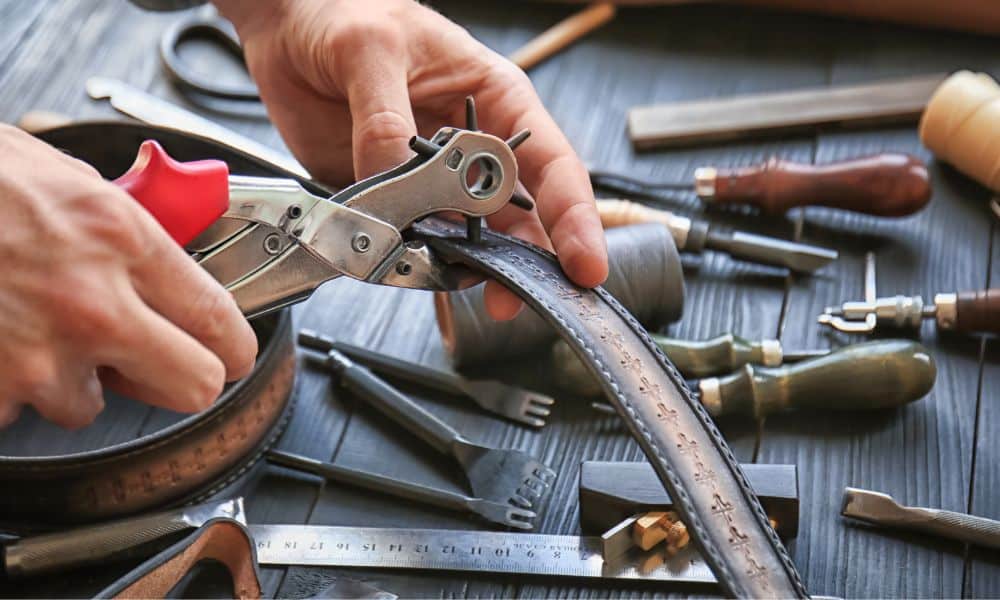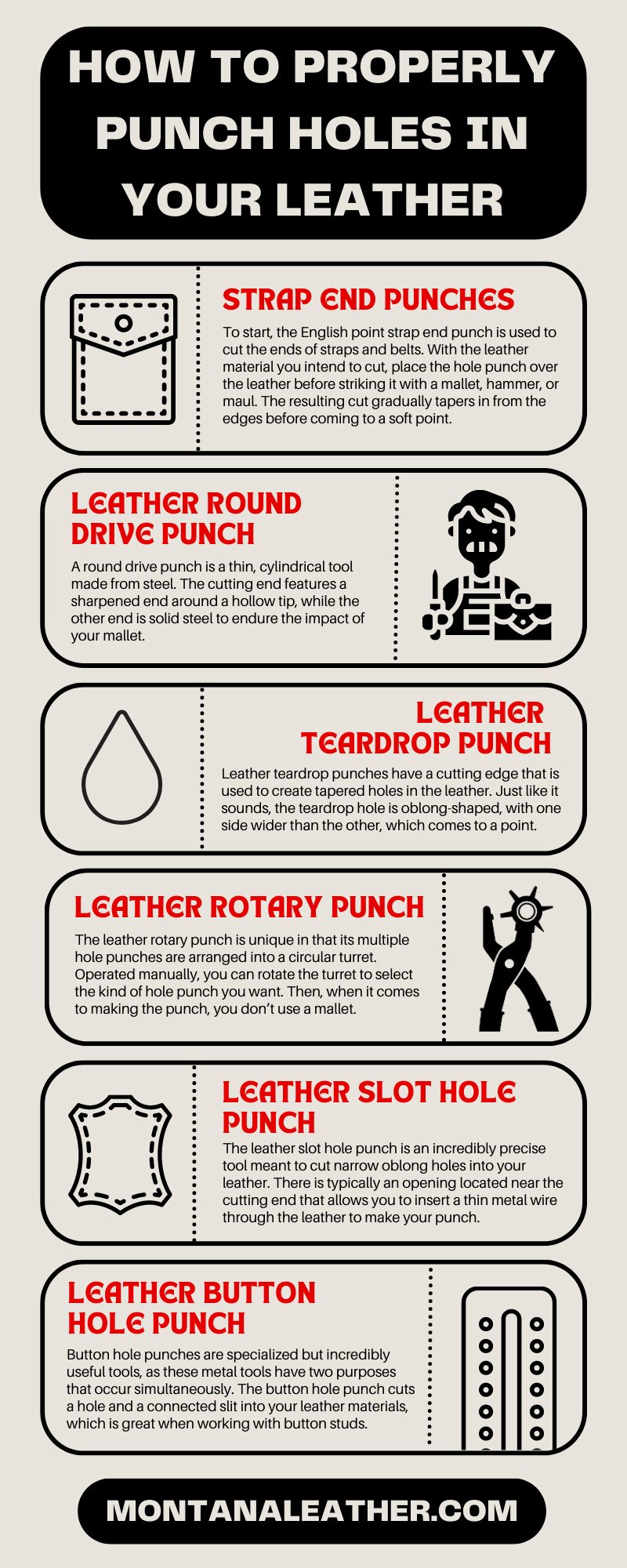
Punching holes in your leather is one of the most common tasks you’ll perform when leatherworking. Thus, a leather punch will be one of the most important leather tools in your kit. Here’s how to properly punch holes in your leather and how to choose the right kind of hole punch for your project.
What Is a Leather Punch?
If you’ve never used one before, leather punches are tools that have rounded blades designed for cutting holes into leather. Specifically, the base has sharpened edges around a hollow metal cylinder that only creates perfectly circular punches. When searching for a hole punch, there are individual tools that only use a single blade, but there are also hole punches that allow for interchangeable blades. This adjustability is convenient because it allows a single handle to accommodate multiple blade sizes for greater versatility.
So why do you need a tool specifically for punching holes in leather? While it is convenient for properly punching holes in your leather, it also requires a great deal of force to actually punch through leather materials. For that reason, leather punch tools are built to be strong and durable to withstand the force of a maul or mallet. Other cutting tools not made to handle thick materials may simply break if the same force is applied.
When punching holes in leather, make sure you set the leather material on top of granite, as it will absorb the force of the impact and prevent your table from being damaged.
Strap End Punches
To start, the English point strap end punch is used to cut the ends of straps and belts. With the leather material you intend to cut, place the hole punch over the leather before striking it with a mallet, hammer, or maul. The resulting cut gradually tapers in from the edges before coming to a soft point. This shape is both practical and stylish, and it comes in a variety of sizes to fit your project’s needs.
The round strap end punch is made specifically for cutting the rounded ends of straps and belts. When positioned and struck with a mallet, hammer, or maul, a semi-circular cut is made. This process is just like the English point punch, and there are also various sizes to match your needs.
Leather Round Drive Punch
A round drive punch is a thin, cylindrical tool made from steel. The cutting end features a sharpened end around a hollow tip, while the other end is solid steel to endure the impact of your mallet. When set on leather and hit, the hole punch is “driven” through the leather to create a clean hole. As you continue punching holes, little leather circles that were cut out will gradually build up in the hole punch and eventually rise out of the back end. This is helpful, as it prevents the discarded leather from scattering all over your workstation.
Round drive hole punchers are a mainstay in most leatherworking tool kits, and you’ll need to decide if you want multiple hole punches with a single blade or a handle that can change out between different blade sizes. There are also oval hole punchers that operate in the same way as the round drive punch.
Leather Teardrop Punch
Leather teardrop punches have a cutting edge that is used to create tapered holes in the leather. Just like it sounds, the teardrop hole is oblong-shaped, with one side wider than the other, which comes to a point. Like drive punches, these tools are made entirely of steel and feature an incredibly sharp blade for efficient cutting.
With their unique shape, leather teardop punches can fulfill a variety of cutting and punching needs for any project, but they’re most popular for harness work. Like with other hole punch tools, these come in a variety of interchangeable sizes.
Leather Rotary Punch
The leather rotary punch is unique in that its multiple hole punches are arranged into a circular turret. Operated manually, you can rotate the turret to select the kind of hole punch you want. Then, when it comes to making the punch, you don’t use a mallet. Instead, you squeeze the grips of the hole punch, which pushes the punch through the leather and creates a hole. These rotary punches help cut down the time and tedium necessary to switch between tools or swap blades on interchangeable tools. The drawback, however, is that the rotary punch is less precise than normal single-blade tools. The best time to use a rotary punch is when you need to make smaller holes in thinner leather materials.
Leather Slot Hole Punch
The leather slot hole punch is an incredibly precise tool meant to cut narrow oblong holes into your leather. A good example of when slot hole punches are used is when holes are being made to run straps through for bags and cases, or for making the elongated hole for a buckle on a belt. Also known as a oblong or bag punch, this is a vital tool for many different projects.
Leather Button Hole Punch
Button hole punches are specialized but incredibly useful tools, as these metal tools have two purposes that occur simultaneously. The button hole punch cuts a hole and a connected slit into your leather materials, which is great when working with button studs. The button studs are a bit larger so that when slipped between the holes cut in the material, the button stud holds them both together.
The material needs to be flexible enough to accommodate the button stud and to ensure that the stud can fit through these smaller holes. This is done by cutting a slit that is directly connected to the button hole, and the slit makes the leather flexible enough for a larger stud to slip through.
Conclusion
These are but a sample of some of the most common and useful leather hole punch tools. There are many more types of hole punches that fulfill all sorts of niche needs, but these likely won’t be necessary if you’re a leatherworking beginner.
For more information on leather hole punching tools, or assistance finding the exact tool you need, get in contact with our experts at Montana Leather Company today. Our professionals will be happy to provide you with the assistance you need to ensure your projects are successful.

